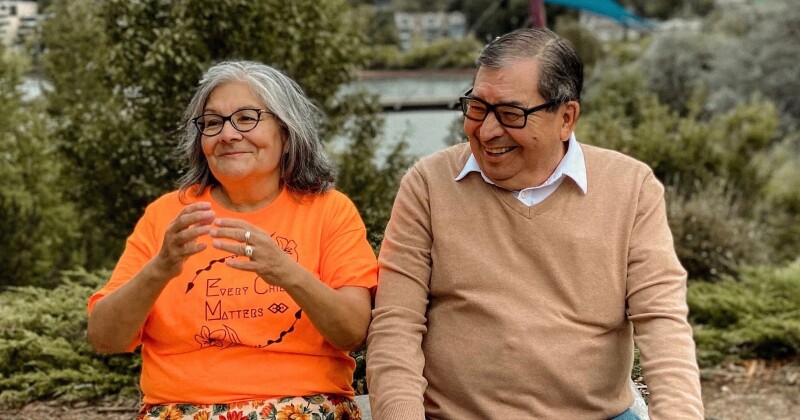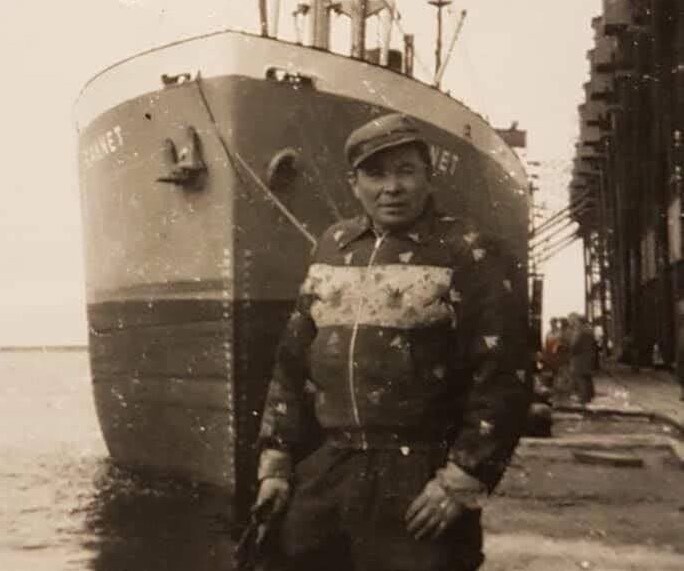As Latter-day Saints prepare to celebrate the 175th anniversary of Pioneer Day on July 24th this year, LDS Living recognizes that in addition to the sacrifices of the early pioneers, there are many modern-day pioneers across the globe who have built the Church in their nations or in their families. In this new series of articles, we wish to recognize these present-day pioneers and remember all who have helped make The Church of Jesus Christ of Latter-day Saints what it is today.
The Indigenous Cree people are the largest tribe in Canada, with a massive empire that started in the east hundreds of years ago and today stretch from Labrador, Quebec, Ontario, Manitoba, Saskatchewan, Alberta, eastern British Columbia and northern Montana. Over generations, as Indigenous Cree principalities moved westward, their bravest and fiercest warriors became chiefs and occupied other leadership positions. They had a matriarchal order that kept a check on the powers of leaders and its councils.
Each rising generation of the Indigenous Cree people was encouraged to vision quest, to learn from dreams and visions, and to interact with the spirit realm. Dreams, visions, and impressions on the spirit helped each person in his life journey. The Old Testament teaches, “Your old men shall see dreams, your young men shall see visions” (Joel 2:28). Dreams and visions were significant in indigenous spiritual life and served as a validation of an individual’s spiritual condition, his worthiness to become a servant of Indigenous Cree. In this way, young people learned the traditional roles of parenting, and some eventually became chiefs and leaders, medicine men and women (or healers), and the wise ones (old people or grandparents).

This story is about Harry Thomas Michael, who was born on March 25, 1915, on the Beardy’s Cree Reserve between the North and South Saskatchewan rivers near Saskatoon, Saskatchewan. In his 20s, during the great economic struggle or the Great Depression, Harry distinguished himself among the Indigenous Cree on the Beardy’s Reserve as an outstanding athlete when he became a boxing champion of his weight division. Boxers of that era were offered little or no money to fight. Harry and other fighters fought because they had courage, and because they had the passion. Harry was brave and fierce in the boxing ring.
Beginning in 1951, Harry was elected chief for two terms and then served for more than three decades on the Band Council as a Headman on Beardy's Reserve. As the chief, he was one of many Indigenous leaders who advocated for and established a political organization called the Federation of Saskatchewan Indigenous Nations (FSIN) to address the plight of Indigenous people in Canada. Self-governing structures that were established by the FSIN included the First Nations University of Canada, which today combines Indigenous traditional knowledge with scholarship and education to enable the rising generation to “search for” their rightful place in Canadian society.
Nitona is a Cree word that means to “look for it” or to “search for something.” Harry’s search resulted in being baptized and confirmed a member of The Church of Jesus Christ of Latter-day Saints on July 5, 1971, at the age of 56. Before his baptism, Harry had a dream in which he was standing on a cloud gazing at the bright blue sky with white clouds for a landscape. As he looked around, two young men were walking by him. As they walked by, they beckoned him to come with them. He desired to do so, but when he took one step, he immediately fell through the cloud up to his ribs.
The young men encouraged him to take another step, which he did. Again he stuck into the cloud. The young men kept encouraging him and he found that as he struggled, he didn’t sink as deep with each new step. Eventually, he was able to walk with ease. Several months later, he answered a knock on the door of his home. It was two youthful priesthood holders who were missionaries from The Church of Jesus Christ of Latter-day Saints. They were the two young men of his dream.
At the center of the universe is a fountain that is the source of all dreams, visions, spiritual knowledge, and wisdom. Harry knew from the fountain of truth that a 14-year-old boy, Joseph Smith, had a vision of the Universal Father and Creator. Even from the smallest particle from the fountain, Harry had received an impression of the truth of that vision. Harry knew that Joseph Smith had been called to be the Prophet of the Restoration.
Indigenous people on the Beardy’s Reserve who had held him in high esteem ostracized Harry for a season because they did not understand why he had converted to a new religion. He stayed active because he knew his dream meant the missionaries had brought a new way of life. Harry often bore his testimony in church and in his home that he had found his true heritage, that he had a heritage that extends to Adam and Eve, to Moses, Abraham, Lehi, and to other prophets from the scriptures of The Church of Jesus Christ of Latter-day Saints.

Harry often bore his testimony that he knew the people in the Book of Mormon were his ancestors, that his people had migrated from Jerusalem to the Americas. He had received the wisdom and truth that the Indigenous Cree of Canada were “of the house of Israel, and they shall know and come to the knowledge of their forefathers, and also to the knowledge of the gospel of their Redeemer, which was ministered unto their fathers by him; wherefore, they shall come to the knowledge … of his doctrine, that they may know how to come unto him and be saved” (1 Nephi 15:14). Sharing spiritual experiences and testimonies of ancestors that echo from generation to generation are part of what Indigenous Cree call acimowin (meaning “to tell a story”). Harry discovered many acimowin (stories) about his ancestors in the Book of Mormon.
Acimowin is a Cree tribal iconic tradition to provide valuable information to the next generation in a passionate and attention-grabbing way. Acimowin is Cree oral literature and a form of telling their history. Indigenous Cree still perform their epic storytelling during social visits in their homes; at powwows, round dances, and ceremonies; and at wakes, funerals, and other significant community gatherings.
The word Cree does not exist in any Indigenous language; Nehiyawayak was what the Cree called themselves and were known by other tribes. The word Cree originated from the French word Kristineaux, which the early European fur traders used to identify the Nehiyawayak of northern Quebec. Kristineaux was later shortened to Kri and to Cree in English. Today, Nehiyawayak in Canada are known by everyone simply as the Cree First Nation.
In an era when there were no cities or transportation systems, living off the land in a wilderness was difficult and dangerous. Indigenous Cree always taught their children that dreams and visions provided practical and spiritual guidance in a harsh environment. Dreams and visions were survival tools. In that era, the Indigenous Cree navigated their way in the vast regions of Canada without road maps or GPS navigation devices, and the land and its vast resources provided for a successful way of life.
In the depths of winter, they looked to dreams and visions to scout out the location of animals of prey. They not only knew when to hunt, but how to find something edible to forage in each season; when to gather berries, herbs and plants for food and medicine; and how to start a fire anywhere to cook food and to keep warm. Indigenous Cree were taught how to survive from their dreams and visions, but the early Europeans were taught how to survive and live off the land from the Indigenous Cree and other tribes.
The post-Confederation Treaties between Europeans (the Crown) and Indigenous tribes were made between 1871 and 1921 in Canada. As an indigenous leader, the people on the Beardy’s Reserve knew Harry as one of the most knowledgeable of the historic treaty-making. Before Europeans, Indigenous tribes made treaties with each other as a framework for coexistence, for peace and friendships, for intertribal trade alliances, and for safe passage and resource-sharing in each other’s ancestral lands. It was common practice for treaty negotiations to encompass epistomologies and protocols like Indigenous and European languages, laws, relationships, beliefs, values, and ceremonies, symbolizing Nation-to-Nation agreements and providing a sense of responsibility for the past, present, and future.

At the time the Post-Confederation Treaties were negotiated, Indigenous tribes experienced great hardships, and some were at a point of near extinction. In the Book of Mormon, 1 Nephi 13:10–14 states that Europeans or Gentiles would come and many generations of Indigenous tribes would experience great hardships and would be nearly destroyed. One chief who refused to attend treaty negotiations in Fort Carlton, Saskatchewan, on August 23, 1876, was Chief Beardy; the Beardy’s Reservation was named after him. He knew that the difficulties of his people would not end once the treaties were signed. Chief Beardy was known to possess great spiritual powers or “medicine.” The written record of the Treaty Commissioner called him a visionary—because it was only when Chief Beardy had a vision that a special meeting was held with him on August 28, 1876, where he finally signed the terms of Treaty Six with the Treaty Commissioner. In his vision, Chief Beardy saw many generations experience many hardships but they would not perish, and the purposes of the Post-Confederation Treaties was so a future generation of Indigenous tribes would rise again to become a great nation and would achieve their true destiny.
In place of their traditional territories, customs, ceremonies, beliefs, and indigenous languages, Indigenous Cree had to live in extreme poverty on Indian reservations. Children lost the comfort of home, parents, and communities to a residential school system. The education at residential schools was poor, and few went beyond grade six. The girls in the residential schools had jobs like cleaning, while boys like Harry worked on the farm and maintenance. The children were essentially free labor.
Residential schools were harsh and unfair. Not feeding the children properly was common, and they were not allowed to speak their own indigenous languages or to say or do anything related to their culture. If children broke rules, they were severely punished. In recent years, it has become common knowledge that students were abused physically, sexually, emotionally, or psychologically. As a result of these terrible living conditions, many students died at residential schools. Many families and communities were never even notified of their children’s deaths.
Survivors and even children of survivors continue to feel the impact of the residential schools today. Having grown up without families and with abusive adults in their lives, many survivors abused their own children. To deal with the pain that residential schools caused, survivors have become addicts after years of abusing substances. The suicide rate among residential school survivors is very high.
As a survivor of residential schools and a convert to The Church of Jesus Christ of Latter day Saints, Harry looked forward to the day that in which President Wilford Woodruff said the chiefs will be filled with the power of God and will receive the gospel, and they will go forth and build the New Jerusalem (see Journal of Discourses, 15:282); a day when President John Taylor said “the same organization of priesthood, must be introduced and maintained among the house of Lehi as amongst those of Israel gathered” (Letter to A. Carrington, Oct. 18, 1882). President Brigham Young also spoke about the conversion of Indigenous tribes like the Cree when he said: “Look to see them like a flame of fire, a mighty rushing torrent, like the grand march of angels” (Young Woman’s Journal, May 1890, 263).

